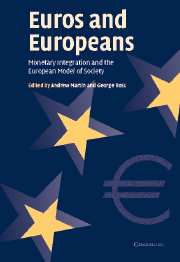Book contents
- Frontmatter
- Contents
- Preface
- List of contributors
- 1 Introduction: EMU and the European social model
- 2 The EMU macroeconomic policy regime and the European social model
- 3 Shaping a polity in an economic and monetary union: the EU in comparative perspective
- 4 Monetary integration and the French model
- 5 EMU and German welfare capitalism
- 6 Maastricht to modernization: EMU and the Italian social state
- 7 Constraint or motor? Monetary integration and the construction of a social model in Spain
- 8 The Netherlands: monetary integration and the Polder model
- 9 Belgium: monetary integration and precarious federalism
- 10 The political dynamics of external empowerment: the emergence of EMU and the challenge to the European social model
- 11 Welfare reform in the shadow of EMU
- 12 Industrial relations in EMU: are renationalization and Europeanization two sides of the same coin?
- 13 Conclusions
- References
- Index of names
- Index of subjects
6 - Maastricht to modernization: EMU and the Italian social state
Published online by Cambridge University Press: 22 September 2009
- Frontmatter
- Contents
- Preface
- List of contributors
- 1 Introduction: EMU and the European social model
- 2 The EMU macroeconomic policy regime and the European social model
- 3 Shaping a polity in an economic and monetary union: the EU in comparative perspective
- 4 Monetary integration and the French model
- 5 EMU and German welfare capitalism
- 6 Maastricht to modernization: EMU and the Italian social state
- 7 Constraint or motor? Monetary integration and the construction of a social model in Spain
- 8 The Netherlands: monetary integration and the Polder model
- 9 Belgium: monetary integration and precarious federalism
- 10 The political dynamics of external empowerment: the emergence of EMU and the challenge to the European social model
- 11 Welfare reform in the shadow of EMU
- 12 Industrial relations in EMU: are renationalization and Europeanization two sides of the same coin?
- 13 Conclusions
- References
- Index of names
- Index of subjects
Summary
In few EU member states was the tension between EMU and commitment to the ESM so apparent as in Italy in the 1990s. It was a decade of political and policy upheaval that shaped, and was affected by, the EMU process. Moreover, EMU was the catalyst and the basis for a debate about modernization in Italy that left few areas of economic and social life untouched. It will be argued that the vincolo esterno (external constraint) of monetary integration has been instrumental to bringing about changes to the basic economic, social, and political structures of the postwar order (Dyson and Featherstone 1996). It would be wrong to assume that the political and economic elites were passive, benignly accepting European dictates that might undermine their position. A constellation of social and political forces looked to use monetary integration for profoundly different reasons and objectives. For some of the forces on the left, but not exclusively, it was a means to dismantle entrenched political and economic oligarchies of the postwar constitutional order. Some of those vested interests sought to manage the requirements of the external constraints to hold on to their position. There were other political forces that looked to monetary integration as a way of bringing about some form of institutional change, be it economic or constitutional. Yet, they all framed the debate about EMU and its attendant policies as one about “modernization.”
- Type
- Chapter
- Information
- Euros and EuropeansMonetary Integration and the European Model of Society, pp. 126 - 149Publisher: Cambridge University PressPrint publication year: 2004
- 4
- Cited by

